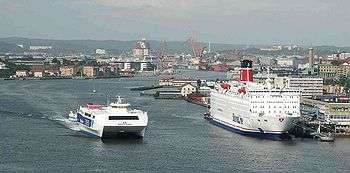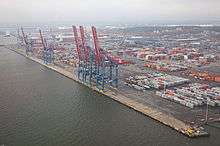Port of Gothenburg

The municipally-owned Port of Gothenburg (Swedish: Göteborgs hamn) is the largest port in the Nordic countries,[1] with over 11,000 ship visits per year from over 140 destinations worldwide. As the only Swedish port with the capacity to cope with the very largest modern, ocean-going container ships, Gothenburg handles nearly 30% of the country's foreign trade, comprising 39 million tonnes of freight per year.[2]
Geography

The port is situated on both sides of the estuary of Göta älv in Gothenburg. The north shore, Norra Älvstranden, is on Hisingen island and the south shore, Södra Älvstranden, is on the mainland. It is a combined river and coastal port and the total length of the dock is 13.1 km (8.1 mi). [3][4]
Port sections
The port is divided into a number of sections or harbors.[5][6]
|
|
Capacity and cargo

In 2013 the port handled approximately 860,000 containers (TEU) and 160,000 new cars (both import and export).[7] It has 24 scheduled rail freight shuttles, serving Norway and Sweden.[2]
The primary imports are crude oil (20 million tonnes in 2013), textiles and food. The primary exports are new vehicles (trucks, cars, buses, heavy plant), steel and paper. There are specialised terminals for containers, ro-ro, cars, passengers (1.7 million in 2013) and oil and other energy products.[2]
The port is large and deep enough to accommodate even very large ships, such as the Maya of the Mediterranean Shipping Company that arrived at the port on 21 December 2015. It was then the world's largest container ship, 396 metres (1,299 ft) long with a draft of 16 metres (52 ft) and a 19,224 TEU capacity.[8]
See also
References
- ↑ "RailPort – Rail Freight Shuttles to the Port of Gothenburg". Nordic Energy Municipality – Nominated municipalities. The Nordic Council. 2011. Retrieved 22 April 2013.
- 1 2 3 "Port of Gothenburg in short". www.portofgothenburg.com. Port Of Gothenburg. Retrieved 31 December 2015.
- ↑ "Göteborgs hamn – Mer än bara gods" [Gothenburg Port – more than just cargo]. www.malmohamn.se. Malmö Hamn. Retrieved 31 December 2015.
- ↑ Bonsdorff, Leo (1931). Göteborgs hamn genom tiderna [Port of Gothenburg through the ages]. Gothenburg: Västra Sverige. p. 6. LIBRIS 1352202.
- ↑ Nilson, Allan T.; Fredlund, Björn (2005). Göteborgs hamn: liv, arbete, konst [Port of Gothenburg:life, work, art]. Sävedalen: Warne. p. 35. ISBN 91-86425-81-1. LIBRIS 9876671.
- ↑ Statistisk årsbok för Göteborg [Statistics for Gothenburg]. Göteborgs statistik, 99-0875351-7. Gothenburg: Göteborgs stadskansli. 1968. p. 118. LIBRIS 8203449.
- ↑ "Containerhamnar". www.goteborgshamn.se. Port of Gothenburg. Retrieved 31 December 2015.
- ↑ Holmberg, Kalle (3 November 2015). "Världens största containerfartyg till Göteborg" [World's largest container ship comes to Gothenburg]. www.dn.se. Dagens Nyheter. Retrieved 31 December 2015.
External links
| Wikimedia Commons has media related to Port of Gothenburg. |
Coordinates: 57°42′N 11°56′E / 57.7°N 11.93°E